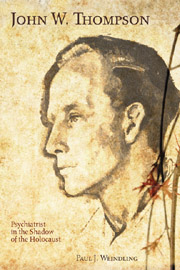Book contents
- Frontmatter
- Contents
- List of Illustrations
- Acknowledgments
- List of Abbreviations
- Part One Into the Dark
- Part Two Redemption
- Part Three Aftermath
- 13 UNESCO: At the Conscience of the World
- 14 The Eau Vive Affair
- 15 Sebastian
- 16 Matthias
- 17 Child Guide
- 18 New York: “St. John the Psychiatrist”
- 19 Hallucinations
- 20 “Dying We Live”
- Appendix John Thompson's Writings
- Notes
- Sources
- Index
14 - The Eau Vive Affair
from Part Three - Aftermath
Published online by Cambridge University Press: 12 September 2012
- Frontmatter
- Contents
- List of Illustrations
- Acknowledgments
- List of Abbreviations
- Part One Into the Dark
- Part Two Redemption
- Part Three Aftermath
- 13 UNESCO: At the Conscience of the World
- 14 The Eau Vive Affair
- 15 Sebastian
- 16 Matthias
- 17 Child Guide
- 18 New York: “St. John the Psychiatrist”
- 19 Hallucinations
- 20 “Dying We Live”
- Appendix John Thompson's Writings
- Notes
- Sources
- Index
Summary
The Mystery
The ideal of a caring community found its realization in Eau Vive. Thompson felt it as
the most significant action, in my opinion, which is being done in Europe or for all I know the world. One day it will be realized and God grant it may not be too late when the realization comes.
He plunged into this “laboratory of love” heart and soul, sustaining the community and caring for the distressed. Here the anxious individual found therapy and an antidote for a sick century. Ill and thirsting souls found sweetness and light. Eau Vive dispensed meditative spiritual balm.
Documentation on Eau Vive's activities remains sparse and even suppressed. Officially it was an international center of spirituality and Christian culture, a community of Catholic students. Thompson's presence gave it a dual role as a place of study and healing for mentally distressed adolescents. Eau Vive was a quietist, bonded community, infused with ardent philosophical concern for the whole person.
The question, Well, what went on there? elicits varying responses. Thompson had a retreat from the stress of UNESCO's bureaucracy and a place to sooth anxious spirits. His wards Sebastian and Wolfgang Littmann found amusement. Natasha Spender and her companions were fascinated by the disturbed young spirits. Thompson's godson, Michael Rosenbaum, found “it's a place where you hung out.” Michael's psychiatrist father, Milton, recollected how people wandered around and did not know what to do with their lives.
- Type
- Chapter
- Information
- John W. ThompsonPsychiatrist in the Shadow of the Holocaust, pp. 203 - 241Publisher: Boydell & BrewerPrint publication year: 2010



